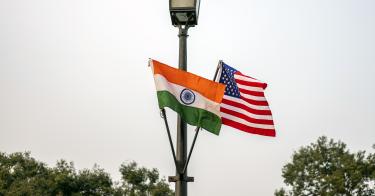Putin’s invasion of Ukraine has profoundly affected the European security order and plunged the West’s relationship with Russia to lows not seen since the Cold War. It is also having some important second-order effects, including raising some uncomfortable questions in the U.S. about India’s longstanding partnership with Russia.
Many U.S. observers find New Delhi’s apparent neutrality toward the invasion puzzling—same for its numerous abstentions on votes to condemn Moscow at the United Nations. Isn’t the world’s largest democracy a strategic partner and a democratic counterweight to China? Why is India cozying up to Putin? Will this roil India-U.S. relations?
The truth is, India and the U.S. have never seen eye-to-eye on Russia. When Washington and New Delhi began forging a special partnership in the mid-2000s, each had existing relationships the other found problematic. America was discomfited by India’s close ties with Moscow; India was even more unsettled by America’s patronage of Islamabad. At the time, they agreed not to let these differences prevent them from acting on an undeniable convergence of interests in the Indo-Pacific.
India gradually came to appreciate that the U.S.-Pakistan relationship was deeply troubled and not directed against India. The U.S. understood that, far from being an enthusiastic supporter of Russia’s belligerent actions abroad and repression at home, New Delhi was bound to Moscow by its dependence on the Russian military-industrial complex and a complicated Cold War legacy.
>>> Sanctioning India for Russian Arms Deal Would Be Counterproductive
We should not allow Putin’s unfolding misadventure in Ukraine to disrupt this understanding or prevent us from concentrating on the bigger prize, where India-U.S. cooperation matters most: the Indo-Pacific and the China challenge.
The Legacy
The unlikely but enduring partnership between India and Russia was heavily shaped by Cold War balance-of-power politics. When India gained independence from the British empire in 1947, it embraced a policy of non-alignment. Facing enormous development challenges—and seeing neither the U.S. nor the USSR as a direct threat—India sought to avoid entanglement in their superpower rivalry.
Despite its best effort to avoid the conflict, the Cold War came to India’s neighborhood. Pakistan, India’s rival, seized the opportunity to align itself with the U.S. against the Soviet Union, even allowing the U.S. to operate spy planes from Pakistani territory.
Washington had no quarrel with New Delhi. It became India’s top supplier of aid in the 1950s and rushed support to India during the 1962 China-India border war. Still, New Delhi viewed American patronage toward Pakistan as threatening and indicative of a pro-Pakistan bias.
This divide was further exacerbated in the early 1970s, when the U.S., in an attempt to leverage growing tensions between Moscow and Beijing, pursued an opening to China. Yet again, a partnership pursued on the basis of mutual animosity toward the Soviet Union positioned America alongside a key rival of India.
Balance-of-power politics compelled India to seek the patronage of its own superpower, and the USSR was the only option available. The two signed a defense pact in 1971 on the eve of the Third Indo-Pakistani War. The pact cleared the way for the Soviet Union to become India’s exclusive defense supplier and its champion at the UN Security Council, even as India avoided enlistment in the USSR’s revolutionary struggles abroad.
During the conflict in 1971, America sent a naval task force to the Bay of Bengal in a show of support to Pakistan. The USSR dispatched its navy in response. Nothing came of the dueling deployments—in part because the war ended abruptly—but Russia began to assume mythical status as India’s loyal guardian. It also produced a cottage industry of pro-Russia experts and a Russophile national narrative that often portrayed America as a colonial aggressor.
India’s Bind
The Soviet Union’s collapse in 1991 weakened the bonds between Moscow and New Delhi, and India began to liberalize its economy and its international relationships. That effort included a budding strategic partnership with the U.S. following the 9/11 terror attacks and a slow diversification away from Russia as India’s exclusive defense supplier.
Nevertheless, more than two-thirds of India’s legacy military hardware is of Russian origin. This includes tanks, fighter aircraft, transport planes, naval platforms, and air defense systems. Unfortunately, there are reasons to believe Moscow is not shy about playing hardball with defense clients it deems to be disloyal, including in the provision of servicing, spare parts, and ammunition. This leaves India with a concerning dependency on Russian goodwill to meet its defense requirements even in the best of times.
And, for India, this is not the best of times. Its rivalry with China is white hot. In 2020, a series of escalating crises at their disputed border culminated in the first deadly clash at the Line of Actual Control. Today, Chinese and Indian forces remain forward deployed and on high alert at several friction points along the border.
Complicating matters further, Russia continues to sell or lease to India advanced military platforms—including nuclear submarines and advanced air defense systems—that the U.S. and others are unwilling or unable to offer. Moscow and New Delhi have also jointly developed advanced cruise missiles. Indian defense officials claim these platforms are vital to its ability to confront challenges from the People’s Liberation Army.
India’s approach to the Ukraine crisis and its aversion to criticizing Moscow can thus be attributed principally to vital defense dependencies, and to historical loyalties to Russia dating back to the Cold War. Additionally, India has a long history of adopting neutral diplomatic positions toward international conflicts, including past U.S. military interventions.
These realities have been lost in some of the Western press coverage of India’s approach to the Ukraine crisis and in some of the shrill, reflexively defensive conversations unfolding in the Indian press. Viral clips reveal Indian talk show hosts and commentators berating U.S. guests when pressed on India’s perceived affinity for Russia, twisting themselves in knots to defend Putin’s actions and reciting a litany of historical grievances with U.S. policy.
In reality, an exceedingly small minority of Indian officials and experts accept Russian propaganda that it is cleansing Ukraine of “Nazis.” A larger proportion, however, believes the U.S. and NATO hold some responsibility for the crisis by seeking to enlarge the alliance eastward.
Nevertheless, I suspect the vast majority of officials and citizens privately oppose Russia’s invasion and want hostilities to end as soon as possible. Far from advancing Indian interests, Russia’s invasion has only created heartburn for New Delhi. It put India’s 20,000 students in Ukraine in harm’s way. (One was killed by Russian fire.) It also brought unwanted scrutiny of India-Russia ties from New Delhi’s partners in America and Europe. Punishing new sanctions from the West may impact Indian companies that do business with Russia.
Most concerning for New Delhi, the invasion has further exacerbated the divide between Russia and the West while strengthening the emerging China-Russia nexus. Many Indian commentators have long held out hope that Russia and the U.S. would set aside their legacy differences and band together with India to confront a larger shared threat: China. This fanciful aspiration has persisted despite Russia’s consistent and accelerating embrace of China over the past decade. While some Indian commentators are beginning to lose faith that Russia can be turned against China, none want to see Moscow move further into Beijing’s orbit.
It is increasingly apparent, however, that in even the best-case scenario for Moscow, Russia will emerge from this misadventure substantially weaker economically, diplomatically, and militarily; more at odds with the West; and more dependent on China.
Looking Ahead
The U.S. government seems to recognize that there are pragmatic motivations behind India’s desire to avoid antagonizing Moscow at a time it is locked in a border standoff with the People’s Liberation Army. To date, Washington has proved flexible, avoiding public criticism of India’s hands-off approach to the Ukraine crisis. “We know India has a relationship with Russia that is distinct from the relationship that we have with Russia. Of course, that is okay,” a State Department spokesman explained in late February.
This is the right approach. It would be inadvisable to invest excessive time and energy trying to budge India from an entrenched position on Russia when even a successful effort is unlikely to produce more than marginal returns. Few believe stronger statements of condemnation from India would materially alter Russia’s calculation in Ukraine. Better to focus on the priority theater—the Indo-Pacific—where convergence is strong and India is consequential, than on the secondary theater where convergence is weak and India’s impact is marginal. In this case, the juice isn’t worth the squeeze.
On Russia-India ties, the best thing the U.S. government can do is take a step back. For years, New Delhi and Moscow have been drifting apart of their own volition. Their bilateral trade is minuscule: less than $8 billion annually, even as India-U.S. trade approaches $150 billion. People-to-people ties are equally tepid. Pre-crisis, more Indians were studying in Ukraine than in Russia. Most important, Moscow and New Delhi diverge widely on India’s principal external security threat, China, toward which Russia is no longer a reliable balancer. Aging memories and military hardware are the only glue holding the relationship together.
>>> Austin Goes to India: An Agenda for India–U.S. Defense Consultations
Russia’s war in Ukraine will only exacerbate the existing divisions between Moscow and New Delhi. Having believed Putin’s promises that he would not invade Ukraine, many Indian officials and analysts were caught off-guard by Russia’s attack. They’ve been equally surprised by the underwhelming performance of the Russian military and the severity of the sanctions imposed by the West.
For the first time in recent memory, Indians are openly criticizing Russia on prime-time television, questioning the morality of the invasion and the wisdom of India’s enduring dependence on Russian military hardware. In a recent roundtable discussion at the Vivekananda International Foundation think tank, experts noted the Russian military’s “visible and abject lack of preparation” and “severe logistical incompetence.” They even questioned the “quality of Russian technology previously thought to be superlative.”
Others are deliberating the merits of depending on a country increasingly aligned with China. When Russia sought India’s support for a favorable UN Security Council resolution on Ukraine in mid-March, New Delhi declined.
One hopes India will use what influence it does have with Russia to privately convey the importance of ending the conflict as soon as possible. But rather than publicly condemning India for abstaining at the United Nations or imposing sanctions for its purchase of Russian military hardware or energy, the U.S. government should recognize the complex India-Russia relationship for what it is: a relic of the Cold War, under duress and showing signs of age.
This piece originally appeared in Real Clear World




